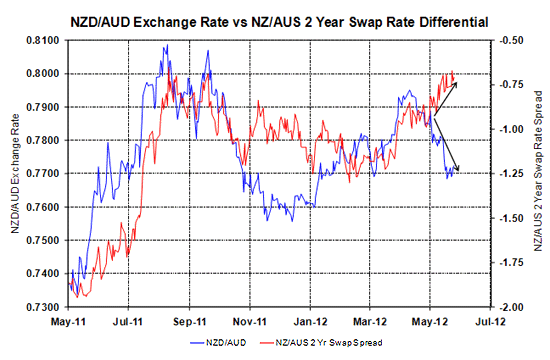
 By Roger J Kerr
By Roger J Kerr
Standing back from the day-to-day movements in the NZD/USD exchange rate and observing the overall pattern over the last six months leads to a simple conclusion;
the Kiwi dollar appreciated from 0.7500 to 0.8300 in late 2011/early 2012 on stronger than expected Chinese economic data (driving commodity prices higher) and in recent weeks the Kiwi has depreciated from 0.8300 to 0.7500 largely due to weaker than expected Chinese industrial production numbers pulling global commodity prices down.
There is no question that the AUD/commodity price nexus is the most crucial determinant of NZD/USD exchange rate shifts.
The risk and fall over the last six months has yet again proven that currency paradigm.
While commodity markets have reacted negatively to potentially weaker Chinese demand going forward, there is no real suggestion that the risk of the global economy heading back into a double-dip recession has increased over recent weeks.
Indeed, the OECD have maintained their global growth forecast at 3.5% for 2012 with Australia forecast to expand at 3.00% this year and 3.7% next year.
There are many reasons why international commodity price should now stabilise after the recent falls, however the key reason has to be that the Chinese have plenty of fiscal and monetary policy firepower in their armoury (unlike western nations) to prevent any marked slowing of growth in their economy. Thus Chinese underlying demand for commodities should stabilise the prices.
The change of leadership in the Chinese Government this year means that they will ensure that their GDP growth out-performs their official forecast target of 7.5%.
Global financial and investment markets understand this Chinese reality and as soon as they see Chinese importers/traders coming back into the market to buy metal and mining commodities at the lower prices they will stop the speculative selling of commodities.
There are indications that Chinese steel production is on the increase again over the last two months and they are importing foreign coal again. A useful indication of the Chinese wanting to buy commodities again at lower prices is when their import-trading houses default on forward supply contracts to buy at earlier agreed higher prices.
One would also expect OPEC oil producing countries to attempt to restrict supplies as the crude oil price (WTI) has recoiled from over USD105 per barrel to USD90/barrel over recent weeks.
The NZD/USD rate has bounced off 0.7500 on two occasions over this last week, indicating a degree of much needed stabilisation and support after plunging eight cents from 0.8300 to 0.7500 without correction.
Global forces will continue to dominate over domestic economic developments as the cause of near-term NZD direction in the forex markets.
The biggest influence continues to be AUD/USD movements and whilst the Aussie dollar has fallen out of favour recently with global investors/currency traders due to weaker domestic economic figures, lower interest rates and decreasing commodity prices, all the aforementioned negatives are now fully priced-in to the AUD/USD exchange rate at 0.9800.
While Chinese economic data is notorious for being inaccurate and perhaps manipulated, their manufacturing indices being released on Friday 1 June will be watched for signs of stabilisation after recent decreases.
Just as important will be US employment and manufacturing data for May being released on the same day.
As previously stated in this commentary, the forces and pre-conditions that could cause a continuation of NZD selling pressure to lower levels in the 0.7100/0.7200 region do not appear to have a high probability of occurring, namely:
- The RBNZ cutting the OCR – now that the NZD has depreciated, the likelihood is very low.
- Global commodity prices falling further – Chinese and US economic data does not support this.
- Sovereign and banking collapses in Europe causing a major sell-off on world sharemarkets – if that had a high probability of occurring the Euro exchange rate would be a lot lower than it is today.
- US economic data turning suddenly weaker also causing lower sharemarkets – unlikely based on current trends, however if it did happen the Kiwi dollar would appreciate as the USD currency weakens on a higher QE3 stimulus probability.
The reasons for a lower NZD from 0.7500 do not seem compelling, the reasons as to why it could rebound to 0.7700/0.7800 are reasonable if commodity prices stabilise and rebound.
The NZD/AUD cross-rate at 0.7730 appears completely out of line with its highly dependable driver, the interest rate gap between NZ and Australia.
Local exporters in AUD should be using this dip in the cross-rate to ensure they are hedged to policy maximums.
The currency divergence from the historical interest rate differential correlation does not look sustainable; the NZD has dropped too far against the USD vis-a-vis the AUD/USD rate.
--------------------------------------------------------------------------------------------------------------------------------
To subscribe to our daily Currency Rate Sheet email, enter your email address here.
--------------------------------------------------------------------------------------------------------------------------------

* Roger J Kerr runs Asia Pacific Risk Management. He specialises in fixed interest securities and is a commentator on economics and markets. More commentary and useful information on fixed interest investing can be found at rogeradvice.com
No chart with that title exists.

We welcome your comments below. If you are not already registered, please register to comment
Remember we welcome robust, respectful and insightful debate. We don't welcome abusive or defamatory comments and will de-register those repeatedly making such comments. Our current comment policy is here.